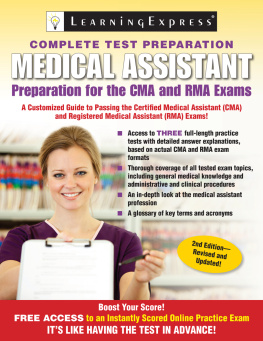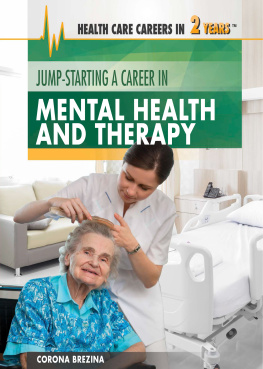CONTENTS
CHAPTER 1 The Medical Assistant Profession
Background and History of the Profession
The Working Environment
Salary and Benefits
Medical Assisting Education and Training
Medical Assisting Credentials and Accreditation Agencies
About the National Exams
Job Readiness and Seeking Employment
CHAPTER 2 The LearningExpress Test Preparation System
Step 1: Get Information
Step 2: Conquer Test Anxiety
Step 3: Make a Plan
Step 4: Learn to Manage Your Time
Step 5: Learn to Use the Process of Elimination
Step 6: Know When to Guess
Step 7: Reach Your Peak Performance Zone
Step 8: Get Your Act Together
Step 9: Do It!
CHAPTER 3 General Medical Assisting Knowledge
Medical Terminology
Anatomy and Physiology
Psychology
Professional Standards
Practice Questions
Answers and Explanations
CHAPTER 4 Administrative Procedures
Data Entry
Correspondence
Equipment
Telephone Techniques
Computer Concepts
Medical Records Management
Mail Screening and Processing
Scheduling and Monitoring Appointments
Resources for Patients
Maintaining the Office Environment
Financial Practices
Practice Questions
Answers and Explanations
CHAPTER 5 Clinical Procedures
Infection Control
Preparing and Maintaining the Treatment Area
Preparing the Patient and Assisting the Physician
Laboratory Testing and Collecting and Processing Specimens
Preparing and Administering Medications
Emergencies and First Aid
Nutrition
Practice Questions
Answers and Explanations
CHAPTER 6 CMA Practice Exam
CHAPTER 7 RMA Practice Exam
ABBREVIATIONS AND GLOSSARY
ADDITIONAL ONLINE PRACTICE
CHAPTER 1
THE MEDICAL ASSISTANT PROFESSION
CHAPTER SUMMARY
A medical assistant is a trained, multi-skilled medical professional who performs administrative and clinical tasks in a wide variety of settings, such as medical offices, clinics, and hospitals. Medical assistants can work under the direct supervision of a physician, an office manager, or another healthcare practitioner. One of the fastest growing healthcare careers, the medical assisting profession is expected to continue growing because of the expansion of the healthcare industry and the increasing health needs of the aging U.S. population. These factors make medical assisting a stable career option in the healthcare field.
M edical assisting offers a challenging career to individuals who enjoy working with people and want to be involved in helping people lead healthier lives. A medical assistant has the opportunity to be actively involved in patient care not only by performing many administrative and clinical procedures, but also by providing moral support and comfort to patients of all ages. Working as a medical assistant is a rewarding profession that can provide personal satisfaction by fulfilling a vital role in the medical office.
Background and History of the Profession
A profession is a calling or a vocation founded on specialized educational training. Historically, medical assistants were trained on the job, because no structured educational facilities were available to teach students the administrative and clinical skills needed in the physicians office. Over the years, because of advancements in technology, an increased need for qualified medical assistants, an increase in malpractice lawsuits, and a lack of consistency with on-the-job training, various types of medical assisting educational programs emerged. In 1956, medical assisting was designated a profession and a national organization, the American Association of Medical Assistants (AAMA), was formed. Another medical agency, the American Medical Technologists, a national certifying agency for laboratory professionals since 1939, began offering a certification examination for medical assistants in the early 1970s. These professional organizations were instrumental in shaping the educational requirements needed for medical assisting programs and listing the skills for the administrative and clinical areas of medical assisting.
The duties of a medical assistant may vary depending on the place of employment, the size of the medical practice, and the specialty of the practitioner. Although a medical assistant may work in a variety of medical facilities, the majority work in physicians offices and other outpatient facilities. The medical assistant is an important team member in such offices and facilities and is responsible for their smooth and proper operation.
The Working Environment
Many medical assistants work a 40-hour workweek, Monday through Friday, although the type of facility where the medical assistant is employed may require medical assistants to work some evenings, weekends, and even holidays. For example, walk-in centers and hospitals are open seven days a week and 24 hours a day, and need medical assistants to work various shifts to cover these hours.
The environments in which medical assistants work are usually busy and involve constant interactions with many people, as medical assistants often serve as a liaison between the patient and the physician. Administrative medical assistants typically work in the front office and perform a number of administrative duties. These tasks include:
greeting patients
answering the phone and triaging (screening) incoming calls
taking phone messages
collecting patient data during registration
setting up and maintaining patient records
scheduling patient appointments
billing and payment collection
posting patient charges and payments
handling correspondence
processing outgoing mail
scheduling inpatient and outpatient diagnostic procedures and laboratory tests
maintaining inventory
ordering supplies
handling correspondence
processing insurance claims
Whats in a Name?
A patient calls to you, a medical assistant, as you walk down the hall of the medical office, Nurse, Nurse. What should the medical assistant do? He or she should respond to the patient, but also should inform the patient that the medical assistant is not a nurse. If the patient is not correctedand is left to believe that he or she is speaking with a nurse and not a medical assistanta charge of the illegal use of the title nurse may be brought against the medical assistant. This is a felony punishable by law.
The administrative medical assistant sets the tone of the medical office. He or she should provide a warm, friendly environment for all patients. The medical assistant is usually the first person to make contact with a patient, either by phone or when the patient arrives for his or her appointment. First impressions are important, and a skilled medical assistant is trained to project a warm personality, making patients feel welcome and confident in the medical care they are to receive.
Clinical medical assisting skills include:
taking medical histories
measuring vital signs
performing diagnostic procedures such as electrocardiograms
preparing patients for examinations
assisting physicians in medical and surgical procedures
changing dressings
removing sutures
preparing and administering medications (depending on state laws and regulations)
drawing blood (phlebotomy)
collecting and processing laboratory specimens
providing patient education
The working environment in a medical facility demands much interaction and communication with patients and their families and with other members of the healthcare team. A medical assistant needs critical thinking skills, a wide range of administrative and clinical skills, and good communication skills. The skills performed will vary depending on the type of facility.











